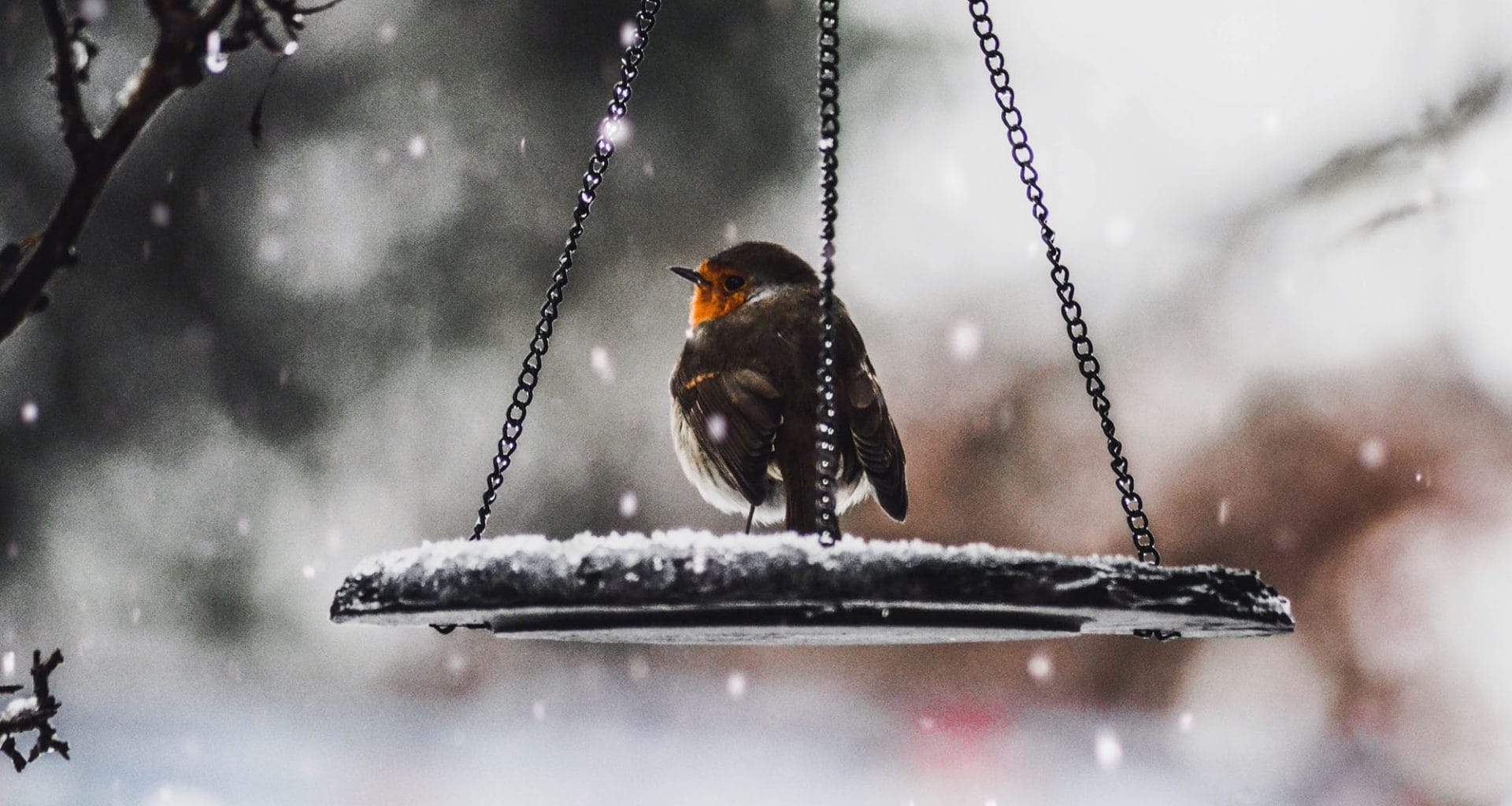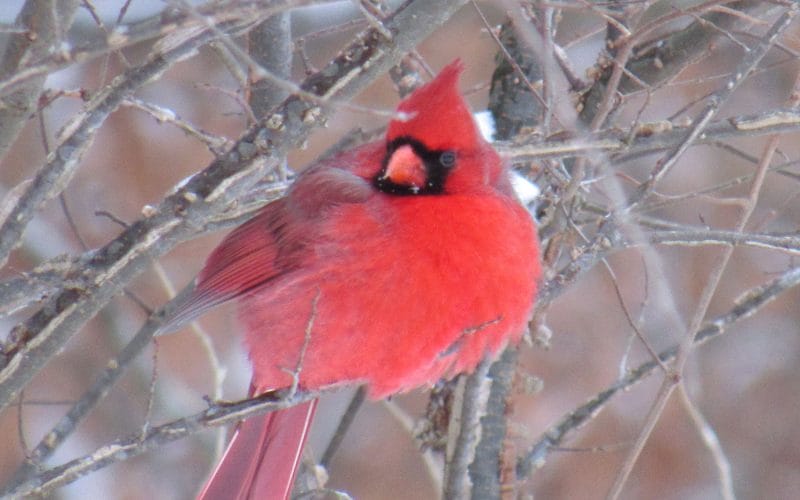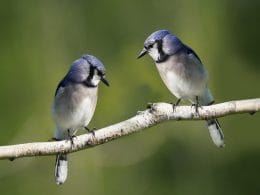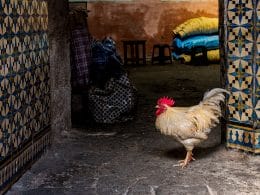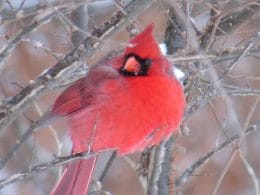American Robins are among the most common songbirds in the United States. Their striking features make them a sight to behold. One of the most common questions people ask is, what do robins eat in the winter?
Typically, robins eat berries and other small fruits found on trees, vines, and shrubs in the winter. They also love dried blueberries, cranberries, and raisins.
In this post, we’re going to discuss everything you need to know about robins, including how to attract robins in your very own backyard.
What Do Robins Look Like?
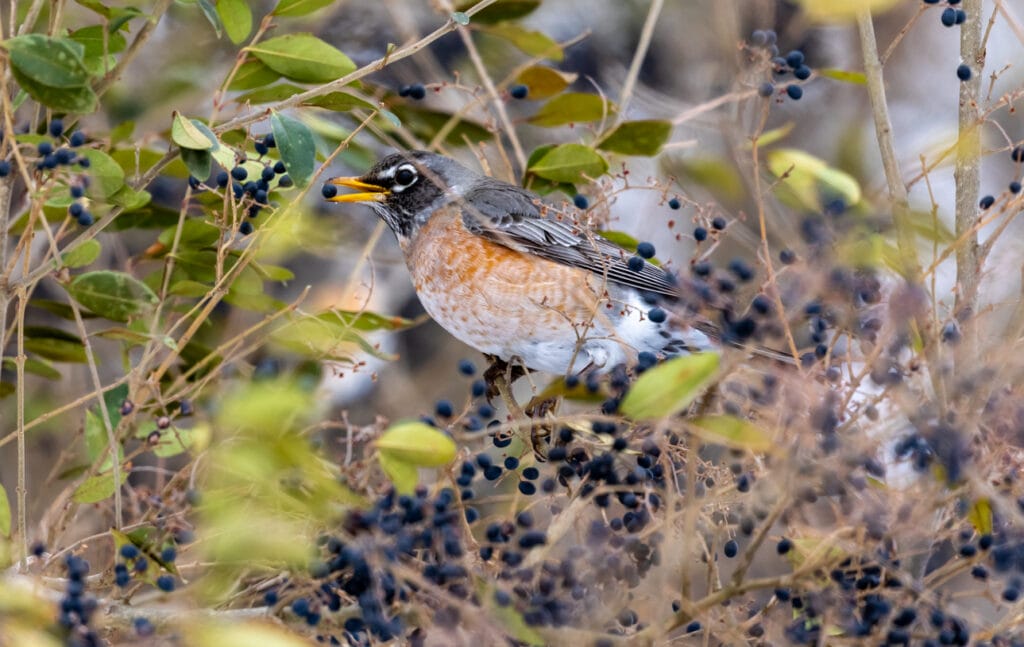
Robins are small, plump birds that are often no more than 9-11 inches. They have warm orange breasts, white bellies, brown backs, and red cheeks.
The white patch on their lower belly and tail are conspicuous during flight. Their wingspan typically ranges from 12-16 inches long across all subspecies.
In comparison, young robins are speckled brown and gold. Female and immature robins are slightly paler than male robins, but the difference is extremely slight.
Where Do Robins Live?
Robins can be found throughout most of North America. They’re highly migratory and would often spend most of their winters in the southern United States.
They depart south near the end of August and return north anywhere between February and March, depending on the state’s climate.
During summertime, robins often forage out of sight in places such as woodlands, forests, tundras, and mountains near treelines.
You may also find them on lawns, city parks, and fields. In the winter, robins tend to move towards moist woodland where berry-producing trees are abundant.
What Do Robins Eat in Summer, Fall, and Winter?
Author Note: A robin’s diet primarily consists of 60% wild and cultivated berries and fruits, and 40% small invertebrates such as caterpillars, earthworms, grasshoppers, and the like.
During winter, robins may visit garden bird tables including birdfeeders and suets filled with different types of dried fruits, mealworms, and seeds.
Robins are seen to flock to fermented Pyracantha berries. After eating their fill, robins are said to exhibit intoxicated behavior; that is, falling over while flying or walking.
Some of the most common summer berries robins eat include the following:
- Pin cherries
- Grapes
- Elderberries
- Choco cherries
- Red mulberries
- Serviceberries
Fall berries include:
- Apples
- Silverberries
- Mountain ashes
- Dogwoods
- Winterberries
And, finally, robins feast on the following winter berries:
- Hackberries
- Crabapples
- Hawthorn berries
- Highbush cranberry
When it comes to insects, robins prefer soft-bodied invertebrates. They forage on the ground and pounce on worms and similar insects by pulling them up from their hiding spots using their small beaks. It isn’t uncommon to find robins on beaches feeding on small mollusks and insects, as well.
According to Robert Montgomerie, professor of biology at Queen’s University, robins use olfactory, auditory, visual, and vibrotactile cues to detect their prey of choice. Among all four, they mostly depend on their vision and hearing.
What Are the Predators of Robins?
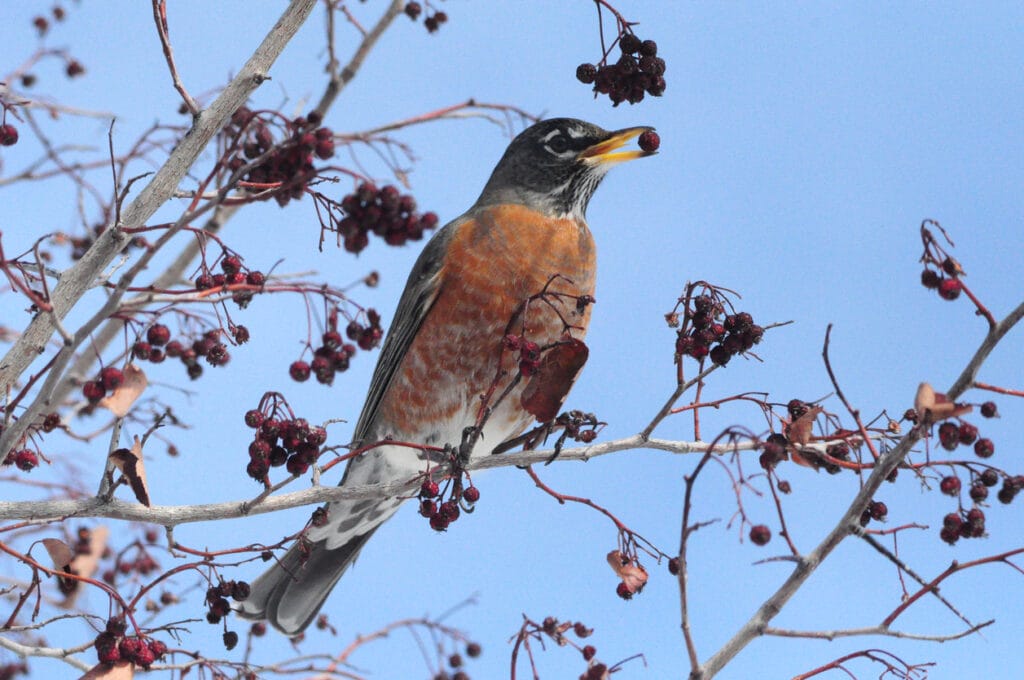
Because robins are so small, they’re prey to many natural predators.
Juvenile robins and eggs are preyed upon by squirrels and snakes, along with several species of birds. This includes blue jays, crows, ravens, and grackles.
Adult robins are eaten by large species of snakes such as rat and gopher snakes, bobcats, foxes, and owls. Hawks, ring-tailed cats, long-tailed weasels, and raccoons are often seen eating robins, too.
It’s said that a total of 28 raptorial birds hunt classify robins as food. They can be attacked while they’re foraging on the ground, in-flight, or during breeding.
Where and When Do Robins Nest?
Robins nest and raise their young in sheltered, secluded spots. This includes dense vegetation, climbing plants, and the inside of hedges.
If they find an old comfortable boot or two, they wouldn’t hesitate to nest there, too! They aren’t awfully picky about their nesting spots.
Robins are surprisingly ferocious when defending their territory. Despite their meek and non-threatening appearance, they can be aggressive if they want to. In fact, male robins might fatally injure or even kill predators and rivals.
Author Note: They’re not as aggressive towards humans in comparison. Robins would sometimes approach gardeners in the middle of work in hopes that they’d help them turn over the soil for insects and worms. This is good news for us robin lovers!
Robins typically lay two to three broods per breeding season (April to July). Nests are built by females alone. Unfortunately, robins aren’t cavity nesters, meaning there’s little chance that they’d use your backyard’s birdhouse for their young.
A single clutch may consist of three to five light blue or white speckled eggs. The eggs would hatch after 14 days of incubation and would leave their nests after two short weeks.
Despite the raising process primarily taken care of by female robins, both sexes protect and feed their young.
Spotting and Attracting Robins to Your Backyard
From countrysides to urban areas, robins can be spotted in gardens, hedgerows, and parks. Robins, specifically male robins, have a complex, continuous song that is often described as cheery.
You can easily identify robins through their bright redbreast. They’re quite small, only about 9-11 inches long.
They communicate amongst each other mumbled cuks or tuks, and are often heard to create repeated chirring sounds that frequently rise in volume.
Apart from when they’re molting, robins are believed to sing throughout the year. They start singing at dawn and stop singing in the evening.
Here are some tips to attract robins to your backyard:
- Regularly place a bowl of fresh water in your garden
- Install bird feeders, suets, or bowls filled with grains, cereals, or dried fruit
- Hang a birdhouse on a wooden pole or tree to keep them warm during winter months
- Plant some berry-rich bird-friendly plants and shrubs including rowans, hollies, guelder roses, and hawthorns
- Ivy and honeysuckle attract insects, thus encouraging robins to visit your backyard to feast on them
Keeping Robins Away From Your Backyard
Despite their friendly nature towards humans, people may encounter their aggression towards other birds.
They might scare other birds away and keep all the food to themselves, making them not the best neighbors for woodpeckers and the like. Furthermore, they might also ruin your vegetable and fruit crops.
Here are some tips to keep robins away from your backyard:
- Hang visual deterrents such as flash tapes, reflective eye diverters, and mirrors around the area in which they’re often seen
- Install garden nettings and barriers to keep robins out of your crops
- Add plastic predator and toy snakes to scare them away
- Spray bird-deterrents and repellents around the area
Keep in mind that robins are protected under the Federal Migratory Bird Act. This means once a robin lays an egg in her nest, the nest is to remain undisturbed until all her hatchlings have safely left. It’s also illegal to kill, hunt, wound, and trap robins. Doing so may lead to hefty fines and prosecution.
Conservation Status of Robins
Robins, specifically European and American robins, are listed as “Least Concern.” Both species of robins are protected by the USA’s Migratory Bird Act and are therefore illegal to kill and shoot without a valid permit.
There are approximately 320 million robins living in the United States and are steadily increasing as the year goes by.
Robin Behavior Towards Humans and Other Birds

Author Note: Robins are primarily active during the day. During winter, they’d often get together for warmth and food. At night, they gather in large flocks in dense vegetation and secluded swaps and would rest atop trees.
When summer comes, robins get a bit more territorial and less social. They’d forage for berries and fruits in small groups with robins they trust.
Robins are one of the few bird species that hold and defend their territory all-year-round. Compared to most other birds, male robins don’t migrate during winter.
Robins are generally tame around humans and would rarely attack. In many cultures, robins are a sign of rebirth, angels, and death. They’re also often associated with storms and the arrival of spring after a particularly dreary winter.
In Christianity, Robins are often depicted in Christmas cards. It’s believed that robins got their fire-red belly from a fire while trying to protect Jesus Christ.
Robin Average Lifespan
Robins have an average lifespan of two years. According to several bird banders, only 25% of young robins survive their first year. The oldest recorded robin is believed to live up to almost 14 years old.
Final Thoughts
Robins eat a variety of foods in winter. They’re omnivorous birds, meaning they feed on both fruits and insects. During winter, robins focus more on berry foraging as berries are quite abundant at this time. However, they certainly wouldn’t say no to a lost worm or two!
Although robins are generally social and friendly, they can be extremely aggressive towards other birds. This is why it’s important to keep watch on your bird feeders to avoid your other bird visitors from being bullied by robins.
We hope this article taught you a little more about robins, what do robins eat in the winter, and shed some light on their behavior and characteristics.
Fly high friends
FAQ
American Robins love worms so if you can stomach it, put mealworms on the feeder. Otherwise you can put out apples and berries.
Well, technically they can. They may well take bread from a feeder and eat it, but that doesn’t mean they should. Try to stick to berries. Any processed, ‘human’ food is like junk food to birds.
American Robins do not eat bird seed because they are not physiologically equipped for it. Their beaks cannot break open seeds and their digestive system cannot process them.




